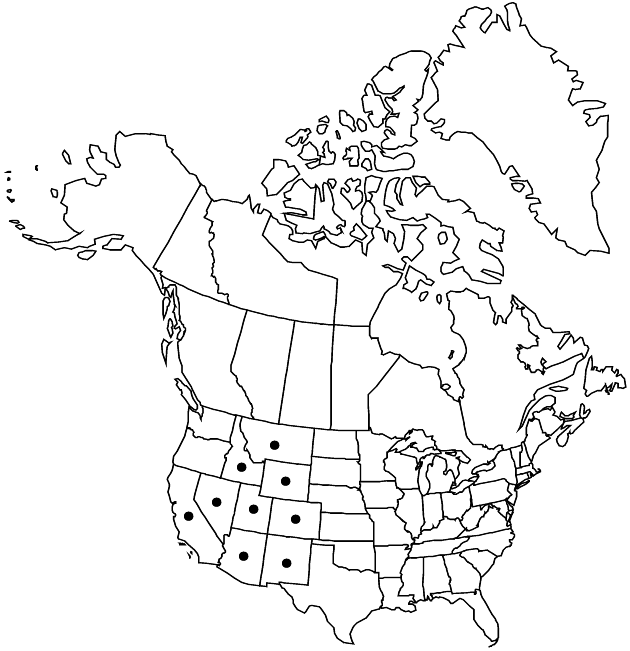Difference between revisions of "Artemisia nova"
Bull. Torrey Bot. Club 27: 274. 1900.
FNA>Volume Importer |
imported>Volume Importer |
||
| (6 intermediate revisions by 2 users not shown) | |||
| Line 8: | Line 8: | ||
}} | }} | ||
|common_names=Black sagebrush;black sage | |common_names=Black sagebrush;black sage | ||
| + | |special_status={{Treatment/ID/Special_status | ||
| + | |code=E | ||
| + | |label=Endemic | ||
| + | }} | ||
|basionyms= | |basionyms= | ||
|synonyms={{Treatment/ID/Synonym | |synonyms={{Treatment/ID/Synonym | ||
|name=Artemisia arbuscula subsp. nova | |name=Artemisia arbuscula subsp. nova | ||
|authority=(A. Nelson) G. H. Ward | |authority=(A. Nelson) G. H. Ward | ||
| − | }}{{Treatment/ID/Synonym | + | |rank=subspecies |
| + | }} {{Treatment/ID/Synonym | ||
|name=Artemisia arbuscula var. nova | |name=Artemisia arbuscula var. nova | ||
|authority=(A. Nelson) Cronquist | |authority=(A. Nelson) Cronquist | ||
| − | }}{{Treatment/ID/Synonym | + | |rank=variety |
| + | }} {{Treatment/ID/Synonym | ||
|name=Artemisia tridentata subsp. nova | |name=Artemisia tridentata subsp. nova | ||
|authority=(A. Nelson) H. M. Hall & Clements | |authority=(A. Nelson) H. M. Hall & Clements | ||
| − | }}{{Treatment/ID/Synonym | + | |rank=subspecies |
| + | }} {{Treatment/ID/Synonym | ||
|name=Seriphidium novum | |name=Seriphidium novum | ||
| − | |authority= | + | |authority= |
| + | |rank=species | ||
}} | }} | ||
|hierarchy=Asteraceae;Asteraceae tribe Anthemideae;Artemisia;Artemisia subg. Tridentatae;Artemisia nova | |hierarchy=Asteraceae;Asteraceae tribe Anthemideae;Artemisia;Artemisia subg. Tridentatae;Artemisia nova | ||
| Line 36: | Line 44: | ||
|elevation=1500–2300 m | |elevation=1500–2300 m | ||
|distribution=Ariz.;Calif.;Colo.;Idaho;Mont.;Nev.;N.Mex.;Utah;Wyo. | |distribution=Ariz.;Calif.;Colo.;Idaho;Mont.;Nev.;N.Mex.;Utah;Wyo. | ||
| − | |discussion=<p>Artemisia nova is the common low-growing dark-green (“black”) sagebrush of desert valleys or south-southwest-facing slopes. It is prized by sheep ranchers as forage in areas where little else is available for grazing. It is conspicuous by its low growth habit, dark green foliage, and, in late season, by its pale orange to light brown flowering branches that rise beyond the vegetative growth. Often confused in herbarium collections with A. arbuscula, A. nova is easily distinguished by the entire leaves of the flowering stems, pedunculate heads, narrowly turbinate involucres, and often straw-colored, glabrous or sparsely hairy phyllaries.</p> | + | |discussion=<p><i>Artemisia nova</i> is the common low-growing dark-green (“black”) sagebrush of desert valleys or south-southwest-facing slopes. It is prized by sheep ranchers as forage in areas where little else is available for grazing. It is conspicuous by its low growth habit, dark green foliage, and, in late season, by its pale orange to light brown flowering branches that rise beyond the vegetative growth. Often confused in herbarium collections with <i>A. arbuscula</i>, <i>A. nova</i> is easily distinguished by the entire leaves of the flowering stems, pedunculate heads, narrowly turbinate involucres, and often straw-colored, glabrous or sparsely hairy phyllaries.</p> |
|tables= | |tables= | ||
|references= | |references= | ||
| Line 45: | Line 53: | ||
-->{{#Taxon: | -->{{#Taxon: | ||
name=Artemisia nova | name=Artemisia nova | ||
| − | |||
|authority=A. Nelson | |authority=A. Nelson | ||
|rank=species | |rank=species | ||
| Line 59: | Line 66: | ||
|publication title=Bull. Torrey Bot. Club | |publication title=Bull. Torrey Bot. Club | ||
|publication year=1900 | |publication year=1900 | ||
| − | |special status= | + | |special status=Endemic |
| − | |source xml=https:// | + | |source xml=https://bitbucket.org/aafc-mbb/fna-data-curation/src/2e0870ddd59836b60bcf96646a41e87ea5a5943a/coarse_grained_fna_xml/V19-20-21/V19_871.xml |
|tribe=Asteraceae tribe Anthemideae | |tribe=Asteraceae tribe Anthemideae | ||
|genus=Artemisia | |genus=Artemisia | ||
Latest revision as of 19:57, 5 November 2020
Shrubs, 10–30(–50) cm (trunks relatively short, widely and loosely branched), pungently aromatic; not root-sprouting. Stems brown, glabrescent (vegetative of approximately equal heights, giving plants a ‘hedged’ appearance; bark dark gray, exfoliating with age). Leaves persistent, usually bright green to dark green, sometimes gray-green; blades cuneate, 3-lobed (lobes to 1/3 blade lengths, 0.5–2 × 0.2–1 cm, rounded), faces sparsely hairy, gland-dotted. Heads in paniculiform arrays 4–10 × 0.5–3 cm (branches ± erect; peduncles slender). Involucres narrowly turbinate, 2–3 × 2 mm. Phyllaries (straw-colored or light green) ovate to elliptic (margins hyaline, shiny-resinous), sparsely hairy or glabrous. Florets 2–6; corollas 2–3 mm, glabrous (style branches scarcely exsert). Cypselae (ribbed) 0.8–1.5 mm, glabrous or resinous. 2n = 18, 36.
Phenology: Flowering mid summer–late fall.
Habitat: Shallow soils, desert valleys, exposed mountain slopes
Elevation: 1500–2300 m
Distribution

Ariz., Calif., Colo., Idaho, Mont., Nev., N.Mex., Utah, Wyo.
Discussion
Artemisia nova is the common low-growing dark-green (“black”) sagebrush of desert valleys or south-southwest-facing slopes. It is prized by sheep ranchers as forage in areas where little else is available for grazing. It is conspicuous by its low growth habit, dark green foliage, and, in late season, by its pale orange to light brown flowering branches that rise beyond the vegetative growth. Often confused in herbarium collections with A. arbuscula, A. nova is easily distinguished by the entire leaves of the flowering stems, pedunculate heads, narrowly turbinate involucres, and often straw-colored, glabrous or sparsely hairy phyllaries.
Selected References
None.